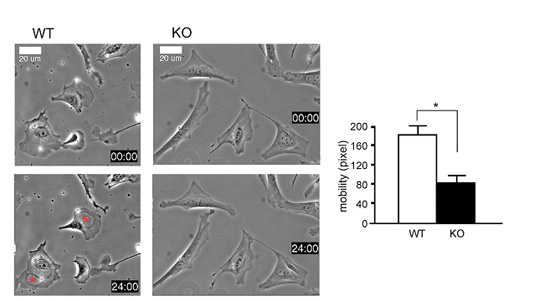DIP/WISH binds to mammalian diaphanous (mDia) and N-WASP, and functions as a scaffold protein by binding to Nck protein (called SPIN90). In addition, DIP/WISH accelerates actin polymerization through integration with N-WASP and is involved in cytoskeletal daynamics. We previously reported that DIP controls the activities of Rho GTPases in a Src-dependent manner, and accordingly contributes to cell motility (Meng et al. 2004). Here, we made the mice lacking DIP/WISH and demonstrated that DIP/WISH is critical for cell motility and adhesion by using murine embryonic fibroblasts (MEF). Rho activity was higher in DIP/WISH-deficient MEF cells even before PDGF or adhesion stimulation. Cell motility and adhesion were impaired in DIP/WISH-deficient MEF cells, and the MEF cells moved little probably due to the deficiency of tail retractions although they had many small membrane ruffles. Consistent with high Rho activity, DIP/WISH-deficient MEF cells exhibited many stress fibers due to clustering pre-existing actin filament. Thus, DIP/WISH is a negative regulator of Rho and modulates cell adhesion by controlling the integration of adhesion molecules.
Tomoko Fukumi-Tominaga, Yoshiko Mori, Atsuko Matsuura, Keiko Kaneko,
Makoto Matsui, Masato Ogata and Makoto Tominaga
DIP/WISH-Deficient Mice Reveal Dia- and N-WASP-interacting Protein (DIP/WISH) As a Regulator of Cytoskeletal Dynamics in Embryonic Fibroblasts
Genes to Cells Vol.14, issue 10

Time-lapse recording of MEF cells from WT and DIP/WISH-deficient (KO) mice upon PDGF stimulation (0 and 24 min). New circle adhesion-like structures are indicated by asterisks in WT MEF cells. KO MEF cells exhibit longer and thinner shapes. Cell movement was observed in WT cells while little movement with rapid and small peripheral raffles was detected in KO cells. Distance of nuclear translocation was significantly shorter for the KO MEF cells (right). * p < 0.05.